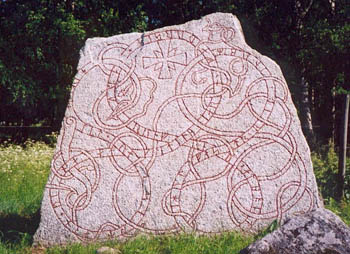
The runic alphabets are a set of related alphabets using letters known as runes to write various Germanic languages before the adoption of the Latin alphabet and for specialized purposes thereafter. The Scandinavian variants are also known as futhark (or fuþark, derived from their first six letters of the alphabet: F, U, Þ, A, R, and K); the Anglo-Saxon variant is futhorc (due to sound changes undergone in Old English by the same six letters). Runology is the study of the runic alphabets, runic inscriptions, runestones, and their history. Runology forms a specialized branch of Germanic linguistics.
The earliest runic inscriptions date from around AD 150. The characters were generally replaced by the Latin alphabet as the cultures that had used runes underwent Christianization by around AD 700 in central Europe and by around AD 1100 in Northern Europe. However, the use of runes persisted for specialized purposes in Northern Europe. Until the early 20th century runes were used in rural Sweden for decoration purposes in Dalarna and on Runic calendars.
The three best-known runic alphabets are the Elder Futhark (around 150 to 800 AD), the Anglo-Saxon Futhorc (400 to 1100 AD), and theYounger Futhark (800–1100). The Younger Futhark is further divided into the long-branch runes (also called Danish, although they were also used in Norway and Sweden), short-branch or Rök runes (also called Swedish-Norwegian, although they were also used in Denmark), and the stavesyle or Hälsinge runes (staveless runes). The Younger Futhark developed further into the Marcomannic runes, the Medieval runes (1100 AD to 1500 AD), and the Dalecarlian runes (around 1500 to 1800 AD).
The origins of the runic alphabet are uncertain. Many characters of the Elder Futhark bear a close resemblance to characters from the Latin alphabet. Other candidates are the 5th to 1st century BC Northern Italic alphabets: Lepontic, Rhaetic and Venetic, all of which are closely related to each other and descend from the Old Italic alphabet.
The runes developed centuries after the Old Italic alphabets from which they are historically derived. The debate on the development of the runic script concerns the question which of the Italic alphabets should be taken as their point of origin, and which, if any, signs should be considered original innovations added to the letters found in the Italic scripts. The historical context of the script’s origin is the cultural contact between Germanic people, who often served as mercenaries in the Roman army, and the Italic peninsula during the Roman imperial period (1st c. BC to 5th c. AD). The formation of the Elder Futhark was complete by the early 5th century, with the Kylver Stone being the first evidence of thefuthark ordering as well as of the p rune.
